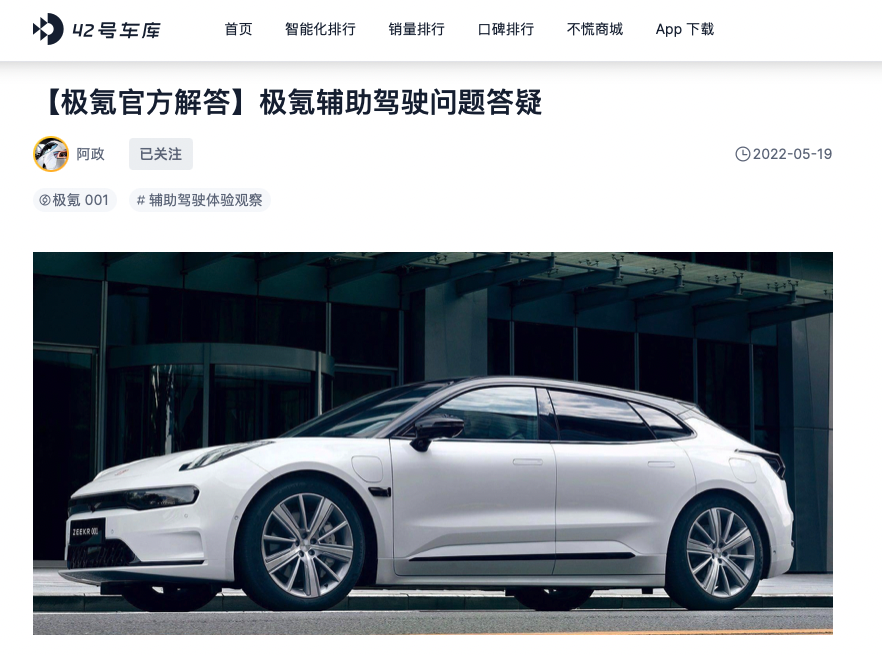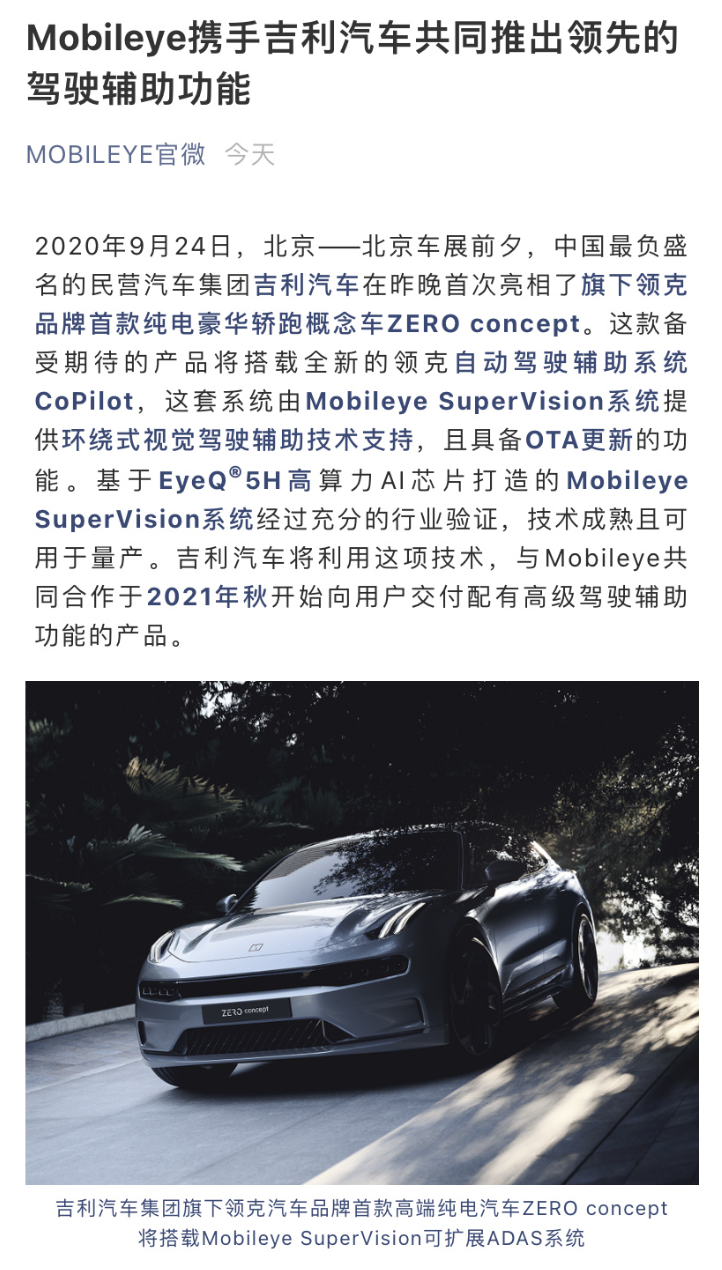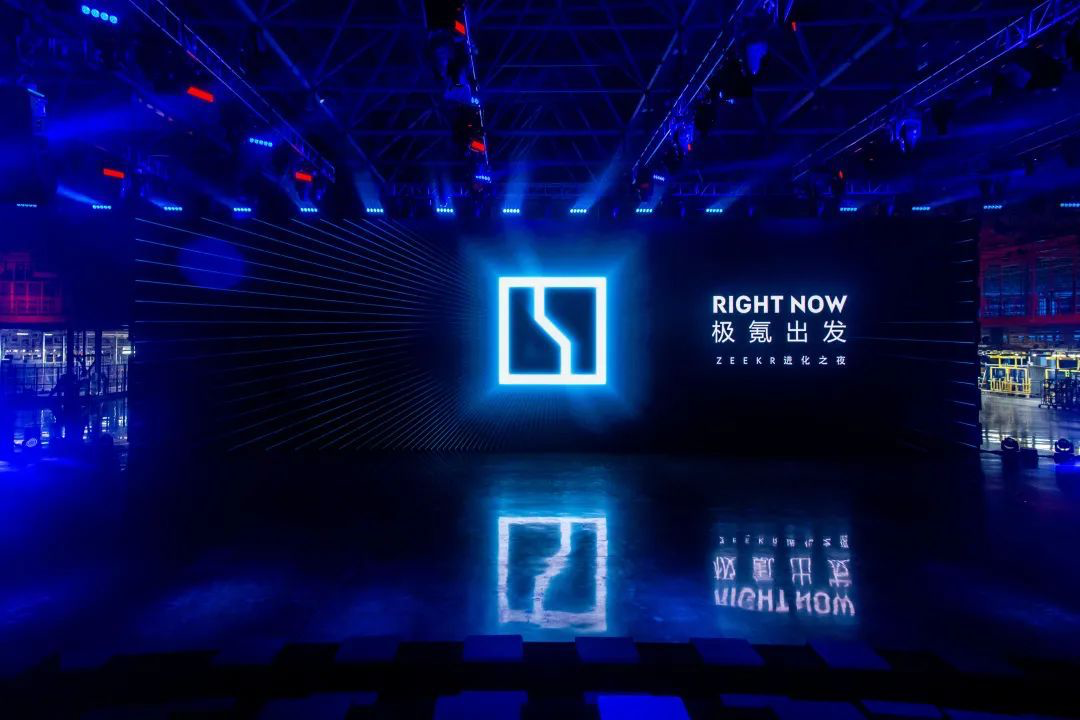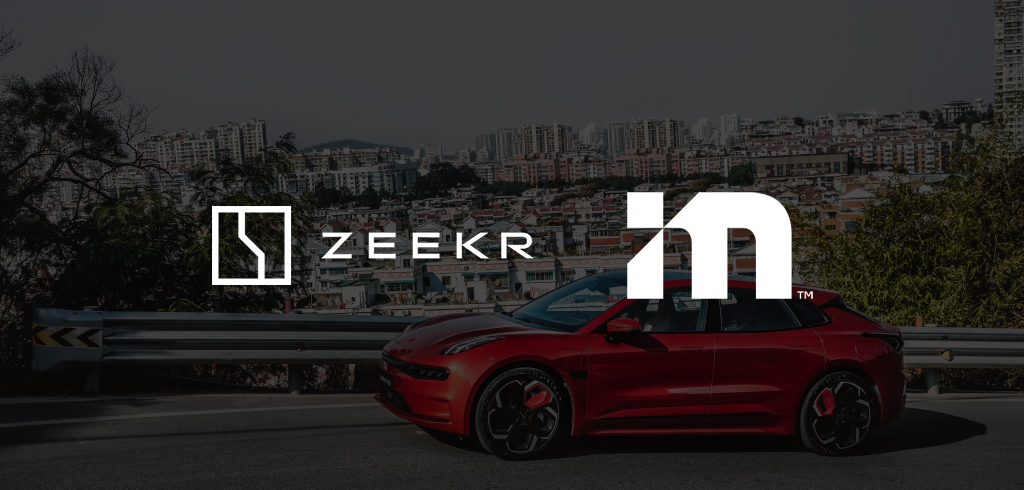Rumors have been circulating recently that “Zeekr will terminate its cooperation with Mobileye”. Given the current status of Zeekr ADAS, this news is not entirely unreliable.
Subsequently, after inquiry from Garage 42, Zeekr officially denied this rumor. At the same time, Zeekr also disclosed plans to launch the lane centering feature on the next OTA update, and explicitly stated that the perception capability of the lateral camera will be utilized to support the lane centering function. (More QA details can be found on Garage 42’s official website by searching for “Zeekr ADAS FAQ”.)

Today we will focus on discussing what the current status of Zeekr ADAS is based on the information we have obtained. What is causing it to fail?
Zeekr Becomes “In a Hurry”
One of the main reasons why Zeekr 001 assisted driving has attracted so much attention from the public is that Zeekr 001 was the first global model to be equipped with the Mobileye EyeQ5.
In September 2020, Mobileye announced that it will cooperate with Geely to launch ADAS function. The system is based on the EyeQ®5H high-performance Al chipset and implements Mobileye Supervision technology. Mobileye Supervision has been fully tested in the industry, has mature technology, and can be used for mass production. Geely will use this technology to cooperate with Mobileye to deliver products with advanced driving assistance functions to users starting in the fall of 2021.

The performance of Mobileye’s previous generation product, EyeQ4, is well known to everyone. As the industry leader, everyone is eager to see the effect of the Supervision pure visual city ADAS, against this backdrop, Zeekr 001 naturally falls under the spotlight.
However, the fact is that since the mass delivery of 001 in September of last year, ADAS related functions have been slow in progress, and it wasn’t until the beginning of this year that Zeekr finally released AEB and ACC to the public. After the release, many users also complained that AEB had a high false trigger rate, and that ACC acceleration was sudden, and that following was very stiff and not linear, the actual experience was not outstanding.
Under high public expectations, Zeekr not only missed the boat, but also handed in a bad answer sheet.
Zeekr delayed, and the chip factory is half responsible.
The biggest problems with the currently existing ZAD system of Zeekr 001 ADAS are slow R&D progress and poor landing experience.According to our understanding, Mobileye is responsible for providing perception data while Zeekr is responsible for regulation and control algorithms to achieve the functionality. According to the Zeekr development team, the delayed progress of functionality is largely due to chip issues. The chip stability time is late, leaving insufficient time for software testing.
Based on the response from the Zeekr team, we can obtain two core pieces of information. Firstly, the chip is delayed, and stable hardware will only be available after mass production of the vehicles. Secondly, software testing will only begin after vehicle mass production, and road test time is difficult to compress.
Our first thought here is Mobileye EyeQ5 chip, but considering that EyeQ5 was put into mass production in 2020 without any delay, it is unlikely that the chip mentioned here is EyeQ5. However, to ensure the accuracy of the information, we have also contacted Mobileye for verification.
Mobileye stated, “The chips are being delivered normally, and there is no delay issue. Mobileye has not been affected by order delivery due to the epidemic.”
Excluding the core assisted driving chip, it may be other links in the domain controller. However, there is a lot of hardware in the domain controller, including not only the main SoC chips but also MCU chips for diagnosis and function monitoring, as well as gateways and PMIC power management.
At the Zeekr media communication meeting last year, Xu Yun, the chief product manager of Zeekr 001, revealed, “Since Zeekr 001 used the 9710 chip for the launch, the chip needs to be redesigned in July, involving changes in hardware-level. Therefore, the ADCU (Autonomous Driving Domain Control Unit) also needs to undergo joint testing, and the entire verification cycle needs to be re-experienced to ensure safety, delaying the release of the ACC function.”
Generally, the time required for chip redesign is not very long. It is the subsequent testing and verification work that is more time-consuming, and the domain controller is a complex hardware. Once one of the chips needs to be returned to the factory, the whole testing work needs to be restarted.
The stable mass production time for all chips in the Zeekr 001 ADCU is in October, so the time given to Zeekr R&D personnel is very tight. This is one of the important reasons why Zeekr 001 ACC was delivered late.Actually, Zeekr X001 bike uses more than 2,000 kinds of chips, with a total quantity of 10,000. Among them, seven chips are industry firsts. However, having more first-release chips also means more risks.
First, there is significant uncertainty with first-release chips. For example, the 9710 chip has no experience in mass production, resulting in stability issues with both hardware and underlying software. Furthermore, intelligent driving is a highly complex and safety-related system engineering.
Secondly, supply chain management is also an important and arduous task, especially in the context of chip shortages in the industry. To ensure chip availability, CEO An Conghui personally leads and closely monitors chip supply dynamics.
Third, integration difficulty is high. Zeekr X needs to integrate products from different suppliers into a domain controller, which requires highly demanding engineering capabilities and hardware design and manufacturing requirements. It is foreseeable that this task presents a significant challenge for Zeekr X.
Most importantly, a main chip first-release such as the EyeQ5 also means starting from scratch, and this research and development progress may exceed expectations.
How difficult is it to first-release chips?
As is well known, the Zeekr X001 model first-released the Mobileye EyeQ5 chip. On the surface, as the first company to use this chip, it is a glorious achievement, but behind it lies many obstacles.
As the first company to do so, Zeekr X bears the responsibility of running the entire process.
For example, XPeng Motors achieved NGP high-speed navigation-assisted driving function through cooperation with Gaode’s high-precision map. In the process of their collaboration, there were inevitably a large number of issues, but the responsible parties for these issues were not always clear. For example, when the system exits on a specific road section, it is unclear whether the problem lies with Gaode’s high-precision map or the vehicle’s own positioning. This process of trial and error takes a lot of time.
After XPeng Motors ran the collaboration, later entrants could naturally get in on the game quickly.
Similar issues arise with Zeekr X.
As usual, during the cooperation process with automakers, Mobileye does not provide camera hardware, only perception algorithms and camera selection recommendations. If someone has already completed the process before, it is generally less likely to encounter issues in this area.However, an insider has revealed to us that prior to mass production, Jidu Auto 001 proactively adjusted the camera parameters, possibly to adapt to more scenarios and achieve better perception performance in some extreme scenarios. For Mobileye, this last-minute adjustment did have a minor impact on the final progress.
At the same time, due to the existence of gain differences between chips, the algorithm used in the 1.3 megapixel camera on the EyeQ4 cannot be directly applied to Jidu Auto, which uses an 8 megapixel camera. So, upgrading to EyeQ5 chip also means the iteration of the perception algorithm.
This kind of pain is not unique to Jidu Auto. Tesla had a similar experience, and currently, both NIO and Li Auto are also dealing with delayed functions and poor user experience caused by initial chip selection.
In 2016, Tesla broke up with Mobileye and switched to a customized version of NVIDIA’s Drive PX 2. However, the 2.0 version of Autopilot was delayed for more than a year and the functional experience was completely incomparable to AP 1.0 based on Mobileye EyeQ3. It turns out that the barrier built by Mobileye over the years in the field of visual perception cannot be broken down overnight.
And last year’s release of the 2021 Li ONE once again proved this point. The 2021 Li ONE abandoned the closed Mobileye EyeQ4 perception system and turned to the self-developed Horizon Journey3. However, after the new car was delivered, a considerable number of users reported that the stability of the new Li ONE ADAS system was not as good as that of the old one. In low-speed situations, it had a “dragon tail” phenomenon, and the promised NOA navigation assisted driving was delayed from the originally planned September until November.
Considering that compared to overseas suppliers, Horizon provided a “nanny-style” service for Li Auto, and the two sides worked day and night to research and develop, compressing the engineering time to a few months.
It is unlikely that Jidu Auto’s collaboration with Mobileye will be as efficient as this. To this end, Jidu Auto has sent personnel to Israel during the pandemic to supervise Mobileye’s processes or joint development—whether both of them is unknown. But what is clear is that Jidu Auto’s internal team, like others before it, will not wait a moment longer than necessary.The latest example of a first-party chip comes from NIO under the NT 2.0 architecture. Its NAD system’s main chip has switched from Mobileye to NVIDIA Orin.

This also brings many problems. NIO once relied on Mobileye to provide stable perception capabilities, but now everything depends on themselves, from perception to decision-making to execution. Even for NIO, the difficulty has increased because they need to integrate the rooftop LiDAR into the perception system, which is extremely challenging.
From the results, NIO has fallen into the “trap”. According to user feedback, the basic ADAS of the ET7 is not yet mature, and it is inferior in experience compared to using Mobileye’s 866 product. And these gaps can only be filled by NIO’s R&D team.
However, users do not care about the process; everyone speaks based on the results. At present, Jidu Auto’s ZAD perception is provided by Mobileye, while the regulations are developed by the Jidu team. But from our understanding, most of the Jidu team came from traditional OEMs and may not have much experience in developing with so many sensors, so the difficulty is beyond expectations. This is also a small reason behind the delayed functionality.
Time waits for no one

Reality is cruel. Apart from a minority of loyal users, most users are rational. Everyone can only see whether you have solved the problem or not, not what problems you have encountered.
This year’s theme for intelligent driving is popularizing high-speed navigation-assisted driving and conquering city navigation-assisted driving.
Among the new forces, Xpeng may take the lead by completing the delivery of urban NGP, while NIO and Li Auto, supported by the new architecture, will surely follow closely and further improve their ADAS capabilities.
Suppliers led by Huawei will also land in-city navigation-assisted driving functions this year. When the progress of your functional mass production is even worse than that of your opponent’s previous generation product, the speed of being left behind by the times may be beyond imagination.
Jidu’s “difficulty” is obvious, but the “crisis” is also self-evident.
This article is a translation by ChatGPT of a Chinese report from 42HOW. If you have any questions about it, please email bd@42how.com.
